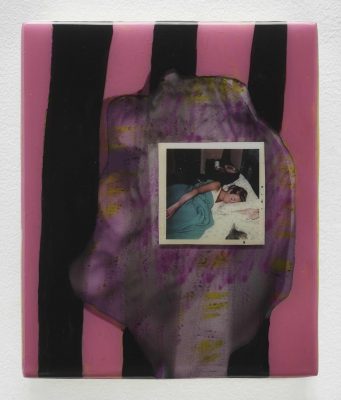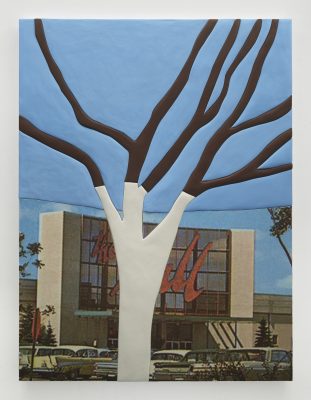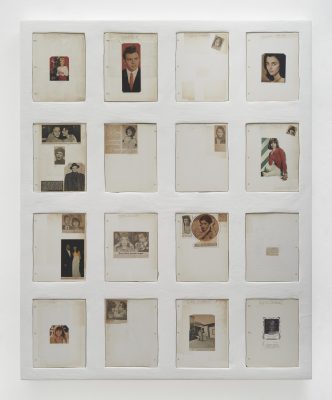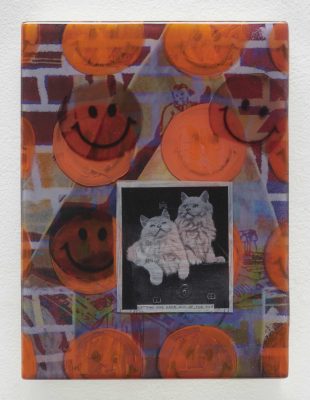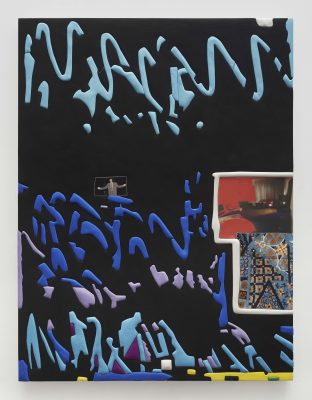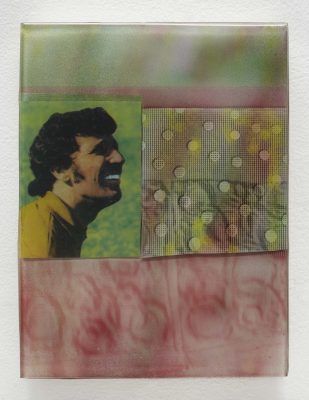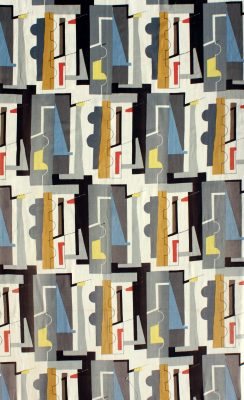The titular work of Sadie Benning’s solo exhibition ‘Sleep Rock’ at Camden Arts Centre takes its name from two images contained within it: a large hand clenched around a rock and an old photograph of a woman asleep in bed. The woman has entered the ephemeral, fluid state of sleep. Her fingers, mirroring the ones that grasp the rock, are closed in on themselves, making a soft, lethargic fist. This dualism crystallises the precarious ‘in between’ states of transition and unconsciousness that reoccur throughout Benning’s practice.
Sleep Rock is one of 19 new wall-based works (all 2018) which constitute Benning’s first solo show in the UK. Incorporating wood, resin, enamel, photographs, hand-drawn imagery and transparencies, the works are a hybrid of painting, photography and sculptural relief. Polished, heavy and projecting at least two centimetres from the wall, Benning’s objects have been slowly accreted over time. Photographs and drawings are suspended between layers of resin so distinct they cast internal shadows. This accumulative process distills and creates relationships: images are read next to, over or through one another. All entombed in a reflective resin casing, Benning’s compositions offer up a multitude of associations and the inescapable reflection of your own face.
Juxtaposing unsettling, familiar and nostalgic imagery, Benning’s resin vignettes exist on the verge of nightmare. In Out of the Bag, lurid orange smiley faces are applied over a cartoonish, purple-grouted brick wall. At the very surface of the work sits a vintage photograph of two white cats emerging from a suitcase, with a caption that reads ‘letting the cats out of the bag.’ Since the 1960s, the smiley symbol has been adopted as an emblem in advertising, children’s TV, adult comic books, acid house culture and at least one series of murders. Set against a brick wall – a familiar backdrop used in live standup comedy – and overlaid with a crude cat joke, they manifest as an ode to enforced, synthetic cheerfulness.
Since the late 1980s Benning has been known for their experimental videos, which they began making as a teenager on a Fischer-Price Pixelvision toy camera. Often recorded in the artist’s bedroom, the films chronicle their nascent sexuality through the presentation of handwritten notes, self-confessional address and personal belongings. In If Every Girl Had a Diary (1990), Benning fluctuates between speaking to the camera as confidante and accuser, and scanning the bedroom for objects that might suddenly reveal or solidify their identity. As a transgender queer youth, Benning’s non-linear approach to video-making was a tool for self-expression when traditional narrative structures failed to articulate their shifting, personal reality. In the static works in ‘Sleep Rock’, Benning’s splicing parallels the mechanisms of video by collaging, cutting, editing, superimposing, and fading. While video editing is dependent upon chronological processes, here the editing occurs on top of itself – like the constant, incremental re-writing of our own constructed identities.
Alongside the resin compositions, Benning has included a series of larger works based around archetypal imagery of mid-century America: anonymous malls, pastel-coloured Cadillacs, motels and hotels. The majority of these resemble oversized, irregular jigsaw puzzles, produced through a complex process developed by Benning. First, a small drawing is projected and traced onto a wooden panel which is subsequently cut into pieces, coated in aqua-resin, sanded, painted and finally reassembled. In Tree Mall (2018) a cut-out of a tree is set against a digitised photograph of a 1950s American mall. The branches are lightly embossed so that they rise and swell just above the surface.
In contrast to these irregular jigsaw constructions, F (2018) is a large white grid, organised around 12 pages taken from a found scrap-book. Each page displays a cutout of an obscure actor whose surname begins with the letter F, taken from a twentieth-century movie magazine. Coated and sunk into the work’s surface, Benning affords the pages an object-like status, a reverent action that parallels the inane dedication of the original collector –cataloging the unknown in an industry which revolves around fame, and using a valueless categorisation system. F is a monument to the absurd compulsive obsessions which can dominate the years between childhood and adulthood.
In an essay written to accompany the exhibition, Leopoldine Core ends with the observation that ‘Sleep Rock’ reminds her of a life without the Internet, ‘or a life that avoids it at all costs – since the Internet stole the medium of the dream [and] remade it badly.’ Although the works on show incorporate digital imagery they remain visceral, physical objects, retaining the analogue sensibility of the films Benning used to make in their bedroom and share by post. In a 2016 interview, Benning declared ‘there are no adequate pronouns for who I am.’ Caught somewhere between a dream and broken nostalgia, ‘Sleep Rock’ articulates the impossibility of growing up, of moving out of the in-between, when the specificity of language fails you.
